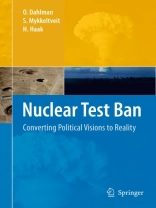Nuclear tests have caused public concern ever since the first such test was conducted, more than six decades ago. During the Cold War, however, con- tions were not conducive to discussing a complete ban on nuclear testing. It was not until 1993 that negotiations on such a treaty finally got under way. From then on, things moved relatively quickly: in 1996, the United Nations General Assembly adopted the Comprehensive Nuclear-Test-Ban Treaty (CTBT). To date, the Treaty has been signed by 178 states and ratified by 144, though it has yet to enter into force, as nine out of 44 ‘‘Annex 2 states’’, whose ratification is mandatory, have not heeded the call. Nevertheless, the CTBT verification system is already provisionally operational and has proven its effectiveness. We commend the CTBT organisation in Vienna for its successful efforts to build a verification network. This book is an excellent overview of the evolution of the CTBT and its verification regime. The authors are eminent scholars from the Netherlands, Norway and Sweden who have been intimately involved with the CTBT and its verification agency, the CTBTO Preparatory Commission, from their inc- tion to the present day. They have written a thorough and engaging narrative of the long road that led to the CTBT. Their story will appeal to both the layman and the expert and provide useful lessons for future negotiations on disarmament issues.
Table of Content
To Test or Not to Test.- Monitoring Technologies.- A Long Journey to a Treaty.- The Treaty.- The Birth of An Organization.- Establishing the Verification Regime.- Testing Shows High Performance.- National Technical Implementation of the CTBT.- The CTBTO Preparatory Commission and the PTS – an Organizational Perspective.- The CTBTO Preparatory Commission and the World.- Always Too Early to Give Up.
Language English ● Format PDF ● Pages 250 ● ISBN 9781402068850 ● File size 8.8 MB ● Publisher Springer Netherland ● City Dordrecht ● Country NL ● Published 2009 ● Downloadable 24 months ● Currency EUR ● ID 2148567 ● Copy protection Social DRM
More ebooks from the same author(s) / Editor
111,769 Ebooks in this category
No results


